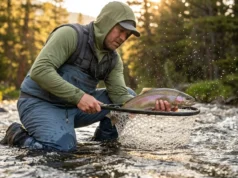In this article
A trophy bass boils on your topwater lure, and you reach for a follow-up bait, only to find a tangled mess of hooks, rusted split rings, and melted soft plastics in your cheap, warped tackle box. That single moment of chaos can be the difference between a photo and a fish story. The truth is, your best fishing tackle box isn’t just a bucket for your fishing gear; it’s the command center for your entire on-the-water operation. This guide moves beyond flimsy latches and basic dividers, arming you with a professional framework and comparison criteria to select a complete tackle storage system that protects your investment, helps you organize a tackle box efficiently, and puts the right lure in your hand when it matters most.
- The System is the Solution: Learn why modern anglers are abandoning the all-in-one container for a modular ecosystem of specialized utility box models.
- Protection Equals Profit: Discover the five non-negotiable performance criteria, from waterproof rating to latch security, that safeguard hundreds of dollars worth of lures from rust and damage.
- Persona-Driven Picks: Find the perfect tackle storage solutions based on your specific angling style, whether you’re a Tournament Angler, a versatile Multi-Platform Hobbyist, or a Finesse & Specialty Specialist needing specific lure fit.
- Data-Backed Confidence: See how we scored and ranked each product against our definitive evaluation framework, so you can make a purchase based on performance, not just marketing.
How to Choose the Right Fishing Tackle Box: An Expert’s Framework
To make a smart, confident choice, we need to deconstruct what truly makes a great piece of fishing tackle storage. This is about moving beyond simple containers and understanding the engineering that protects your fishing tackle and streamlines your time on the water. It’s the foundation for building a system that works for you, not against you, whether you need a single pocket box or a full tackle backpack.
Why Do Durability and Construction Quality Matter?
A hard tackle box is a vault, and its primary job is to protect a financial investment far greater than its own cost. Think about the value of the jerkbaits, jigs, and soft plastics inside—it can easily run into hundreds, if not thousands, of dollars. That vault needs to be rugged enough to withstand the jarring ride of a boat pounding across choppy water, accidental drops onto a concrete boat ramp, and the relentless pressure of being stacked in a storage locker, preventing lure damage at all costs.
High-impact, crack-resistant materials like polycarbonate or heavy-duty polypropylene are non-negotiable for material durability. They provide the structural integrity to prevent the box from shattering or warping under stress. Pay close attention to the hinges, a common failure point on lesser boxes. A weak, molded plastic hinge will inevitably fatigue and break, whereas robust stainless steel hinge pins resist corrosion and provide a durable pivot point that will last for years. Ultimately, quality construction buys you longevity, peace of mind, and the confidence that a catastrophic spill won’t end your fishing trip before it even begins. But a box that lasts forever is useless if it can’t adapt to your ever-changing collection of tackle. This means that after you’ve ensured your gear is safe, you need a system capable of protecting your collection of the best lures for largemouth bass.
How Important is Organizational Versatility (Modularity)?
An angler’s needs are never static. The baits that worked in the cool waters of spring are often replaced by a completely different lineup for the heat of summer. Your target species might shift from bass to panfish, and your techniques evolve with experience. This is why configurability, or “modularity,” has become the pinnacle of versatility in modern tackle storage systems. It’s the ability to completely reconfigure a box’s layout using adjustable dividers, removable trays, or modular bins to match the specific demands of the day.
A major point of frustration for any serious angler is “tackle migration”—that moment you open a box to find your tiny terminal tackle has slipped under a flimsy divider and you now have tangled lures. High-quality systems solve this with rigid, deep-grooved dividers or, even better, fully modular storage system designs that create truly isolated individual tackle compartments. The primary user benefit here is pure efficiency. A well-organized, configurable tackle box means you spend more of your precious time with a line in the water and less time searching for that one specific bait.
Pro-Tip: Once you’ve settled on a modular system, use a label maker or a permanent marker to clearly label the outside edge of each utility box (e.g., “Topwater,” “Terminal,” “Jigs”). This simple step transforms a stack of identical boxes into a high-speed library, allowing you to grab exactly what you need in seconds.
What Level of Weather & Corrosion Resistance Do You Need?
Once your tackle is perfectly organized, the next priority is protecting it from its number one enemy: moisture. Whether from a rogue wave, a sudden downpour, or even just ambient humidity, moisture is the catalyst for the rust that dulls fishing hooks, seizes split rings, and ruins the finish on expensive lures. A high level of rust/corrosion resistance is crucial, especially for saltwater fishing. The goal is to prevent rust entirely.
Effective tackle protection comes in two forms. The first is “passive protection,” the essential physical barrier against water intrusion. The key feature here is a waterproof seal, typically a rubber or O-ring gasket seated in the lid, that creates an airtight barrier, turning your container into a waterproof case. The second is “active protection,” a technology like Flambeau’s Zerust or Plano’s Rustrictor. These systems infuse the plastic itself with a vapor-releasing compound that actively inhibits oxidation. These features translate into a direct financial benefit, dramatically extending the life of your tackle. This level of protection is just as critical as having one of the best saltwater reels with proper sealing. A waterproof tackle box, however, is only effective if the latch holding it shut is reliable and secure.
How Should You Balance Latch Security & Accessibility?
The latching mechanism is the most critical potential point of failure on any box. It represents a crucial trade-off. On one hand, a latch must have absolute latch security, capable of withstanding drops without popping open. On the other hand, it must be easy to operate, ideally with simple one-hand openability for quick bait changes.
The ideal system is a strong, positive-locking mechanism that is also ergonomically designed. Some of the best modern designs, like those on the Plano EDGE series, have moved to a single, oversized latch that accomplishes this perfectly. The benefit is a seamless user experience that combines total security with effortless on-the-water efficiency. Finally, even the most secure and well-organized lure box is only useful if it fits your specific fishing style and environment.
Why is Portability & Form Factor So Important?
There is no “one-size-fits-all” solution because there is no one way to fish. The utility of any tackle box depends on the angler’s specific use case. A bank fishing angler hiking a mile needs a lightweight, compact system, perhaps a soft tackle bag or tackle backpack. A kayak fishing angler needs standardized, waterproof 3600 size or 3700 size utility boxes that stack perfectly in a crate. A tournament boat fishing angler needs a system of deep tray boxes that stack efficiently in large deck lockers.
“Form factor” is the combination of a box’s weight, dimensions, and carrying features. Choosing the correct form factor is about the seamless integration of the storage system into your fishing workflow. The right portable tackle box enhances your efficiency and makes managing your gear feel effortless. This transportability is a key consideration for anglers using one of the best fishing kayaks under $1000, where every square inch of space is paramount.
Our Selection Process: How We Built This Guide
To build absolute trust, we want to be completely transparent about our rigorous research and curation process. This wasn’t about picking what looks good; it was about identifying what performs best in the real world. This is our definitive tackle box review methodology.
Our Commitment to Objectivity: This guide is the result of a comprehensive market analysis, not a sponsored product list. Our recommendations are rooted in a systematic evaluation of objective performance criteria, bolstered by expert reviews from seasoned guides, aggregated user feedback, and precise manufacturer specifications. We accept no free products or compensation to ensure our advice remains unbiased.
The Evaluation Framework: Every product we considered was judged against the five critical performance attributes we detailed above: Durability & Construction Quality, Organizational Versatility (modularity), Weather & Corrosion Resistance, Latch Security & Accessibility, and Portability & Form Factor. Each attribute was scored on a scale of 1.0 to 5.0 to create a standardized data set.
How We Selected the Products: We began with a wide-ranging discovery of dozens of market-leading and innovative tackle boxes, including new-for-2025 products. We then stress-tested and curated this list, selecting only the top-performing tackle box options for three distinct angler personas. This ensures a match for every need, fishing style, and price/budget tier, from the weekend hobbyist to the professional tournament angler.
A Note on Affiliate Links: If you choose to purchase a product through one of our links, we may earn a small commission at no extra cost to you. This helps support our work and allows us to continue providing in-depth, unbiased gear-specific buying advice. We only recommend products that meet our stringent performance standards.
The Best Fishing Tackle Boxes of 2025: Our Top Recommendations for Every Need
Here are the curated top recommendations for our key user personas. We’ve done the research and testing to empower you to make a final, confident purchasing decision that will serve you well for years to come.
Our Top Picks for The Tournament Competitor
This target user demands the absolute highest level of performance, prioritizing extreme material durability, absolute protection, and hyper-efficient organization for high-stakes competitive events. For these tournament anglers, a failed latch or a rusty hook isn’t an inconvenience; it’s a liability that can cost them money. Their fishing gear is a professional tool, and their high-end tackle boxes need to reflect that.
Our Top Picks for The Multi-Platform Hobbyist
This passionate angler does it all. They might fish from the bank on Thursday, a kayak on Saturday, and a friend’s bass boat on Sunday. They need a flexible, portable, and reliable system—often a soft tackle bag or a versatile tackle backpack paired with a set of 3700 utility boxes—that offers a strong balance of performance and cost without being overly specialized for one single environment.
Our Top Picks for The Finesse & Specialty Specialist
This angler has a deep focus on a specific technique, species, or environment. They require purpose-built storage that protects small, delicate, or unique tackle with maximum space efficiency and zero risk of damage. For them, a dedicated jerkbait box like the Daiwa Tactical Long Stickbait Box, a Gamakatsu G-Box Pocket Utility case, or a specialized panfish box is essential; generic solutions don’t work when precision and specific lure fit are key.
Pro-Tip: For ultra-finesse soft plastics like Ned rig baits, store them in their original packaging inside a utility box compartment. This not only prevents them from reacting with the plastic of the box but also preserves any factory-applied scent and keeps their delicate tails perfectly straight.
Conclusion
The best approach to tackle storage in 2025 is to build a modular storage system of utility boxes, not to rely on a single, all-in-one container. Prioritizing features like a waterproof gasket, rust-inhibiting technology, and durable construction is a direct investment in protecting the value of your fishing lures. Modularity is paramount for efficiency and tackle organization, allowing you to tailor your gear for each specific trip and preventing the frustrating “tackle migration” of smaller items. The perfect tackle box is always the one that perfectly aligns with your specific needs as an angler, whether you prioritize portability for bank fishing, stackability for a boat, or specialized protection for finesse tackle.
Armed with this framework, take a fresh look at your current tackle storage. Identify your biggest pain point—be it rust, disorganization, or portability—and choose one of our top-rated solutions to start building a system that works for you, not against you.
Frequently Asked Questions about Fishing Tackle Boxes
Is a fully waterproof tackle box really worth the extra money?
Absolutely. If you store any lures with metal components like hooks or split rings, a waterproof tackle box is one of the best investments you can make. It prevents the rust that ruins expensive fishing lures, paying for itself over time. For a great value in waterproof protection, consider the Plano Next-Gen StowAway Waterproof 3700.
What is the difference between a 3600 and 3700 size tackle box?
The numbers refer to a standardized industry footprint for plastic tackle boxes. The 3700 size is the larger of the two (roughly 14″ x 9″) and the 3600 size is smaller (roughly 11″ x 7.25″). This standardization allows you to buy different tackle trays and utility box models from different brands with confidence they will fit in tackle bags or boat compartments designed for that specific size.
How do I stop my hooks from rusting inside my tackle box?
The best way is to prevent moisture from getting in by using a watertight box with a waterproof O-ring gasket. For an even higher level of active protection, choose a box infused with a rust-inhibiting technology, like the Plano EDGE Flex 3700 Tackle Tray with its Rustrictor infusion.
What is the most important feature for a beginner’s first tackle box?
For a beginner, the most important feature is a versatile and reliable organizational system that can grow with their tackle collection. A system based on the industry-standard 3700 size, like the Plano Next-Gen StowAway Waterproof 3700, is an excellent and budget-friendly starting point that will remain compatible with future purchases.
Risk Disclaimer: Fishing, boating, and all related outdoor activities involve inherent risks that can lead to injury. The information provided on Master Fishing Mag is for educational and informational purposes only. While we strive for accuracy, the information, techniques, and advice on gear and safety are not a substitute for your own best judgment, local knowledge, and adherence to official regulations. Fishing regulations, including seasons, size limits, and species restrictions, change frequently and vary by location. Always consult the latest official regulations from your local fish and wildlife agency before heading out. Proper handling of hooks, knives, and other sharp equipment is essential for safety. Furthermore, be aware of local fish consumption advisories. By using this website, you agree that you are solely responsible for your own safety and for complying with all applicable laws. Any reliance you place on our content is strictly at your own risk. Master Fishing Mag and its authors will not be held liable for any injury, damage, or loss sustained in connection with the use of the information herein.
Affiliate Disclosure: We are a participant in the Amazon Services LLC Associates Program, an affiliate advertising program designed to provide a means for us to earn advertising fees by advertising and linking to Amazon.com. As an Amazon Associate, we earn from qualifying purchases. We also participate in other affiliate programs and may receive a commission on products purchased through our links, at no extra cost to you. Additional terms are found in the terms of service.





